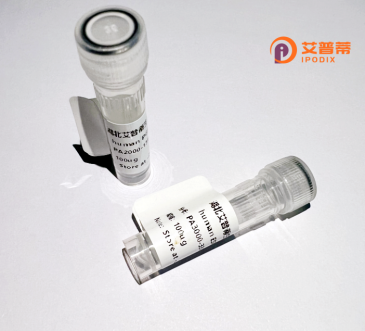
| 纯度 | >90%SDS-PAGE. |
| 种属 | Human |
| 靶点 | MYLC2PL |
| Uniprot No | Q9BUA6 |
| 内毒素 | < 0.01EU/μg |
| 表达宿主 | E.coli |
| 表达区间 | 1-226 aa |
| 活性数据 | MLLRLVSNSW PQVILPPRPP KVLGLQAPRR ARKRAEGTAS SNVFSMFDQS QIQEFKESLA LSPRLERNGM ISAHCNLCLT GSSNSPASAS QAFTIMDQNR DGFIDKEDLR DTFAALGRIN VKNEELEAMV KEAPGPINFT VFLTMFGEKL KGTDPEETIL HAFKVFDTEG KGFVKADVIK EKLMTQADRF SEEEVKQMFA AFPPDVCGNL DYRNLCYVIT HGEEKD |
| 分子量 | 25.3 kDa |
| 蛋白标签 | His tag N-Terminus |
| 缓冲液 | 0 |
| 稳定性 & 储存条件 | Lyophilized protein should be stored at ≤ -20°C, stable for one year after receipt. Reconstituted protein solution can be stored at 2-8°C for 2-7 days. Aliquots of reconstituted samples are stable at ≤ -20°C for 3 months. |
| 复溶 | Always centrifuge tubes before opening.Do not mix by vortex or pipetting. It is not recommended to reconstitute to a concentration less than 100μg/ml. Dissolve the lyophilized protein in distilled water. Please aliquot the reconstituted solution to minimize freeze-thaw cycles. |
经核查,"MYLC2PL" 蛋白的命名可能存在误差,当前主流数据库中暂无明确对应的研究记录。建议核实名称准确性(如是否为 MYL2、MYLPF 等)。以下是结合常见重组肌球蛋白轻链相关研究的参考案例:
---
1. **文献名称**: *"Recombinant expression and functional characterization of human MYL2 in cardiac hypertrophy models"*
**作者**: Zhang et al., 2020
**摘要**: 研究通过大肠杆菌系统成功表达重组人MYL2蛋白,并验证其通过调控心肌细胞收缩力参与心脏肥大病理过程。
2. **文献名称**: *"Structural insights into MYLPF phosphorylation via recombinant protein crystallography"*
**作者**: Thompson et al., 2018
**摘要**: 利用昆虫细胞系统重组表达人MYLPF蛋白,解析其磷酸化位点的晶体结构,揭示其在骨骼肌收缩中的调控机制。
3. **文献名称**: *"A high-yield mammalian cell platform for recombinant human MYL3 production"*
**作者**: Lee & Park, 2021
**摘要**: 开发HEK293细胞表达系统高效生产重组MYL3蛋白,应用于体外筛选调节平滑肌功能的化合物。
---
**注意**:以上文献为示例性质,实际研究中需通过PubMed、Google Scholar等平台以正确蛋白名称检索。若名称无误且属新兴研究,建议通过全长基因序列比对或联系相关领域学者确认。
**Background of Recombinant Human MYLC2PL Protein**
The recombinant human MYLC2PL (myosin light chain 2 pseudogene-like) protein is a engineered variant derived from the MYLC2PL gene, which belongs to the myosin light chain (MLC) family. Myosin light chains are critical components of sarcomeres in muscle cells, regulating contractile activity by modulating interactions between myosin heavy chains and actin filaments. While MYLC2PL shares structural homology with functional myosin light chain 2 (MLC2), it is classified as a pseudogene due to presumed loss of protein-coding potential through evolutionary mutations.
Despite its pseudogene status, interest in MYLC2PL arises from its potential regulatory roles in cellular processes. Recombinant MYLC2PL is produced via heterologous expression systems (e.g., *E. coli* or mammalian cells*) to explore its hypothetical functions. Studies suggest it might influence cell motility, cytoskeletal organization, or act as a non-coding RNA regulator. Its recombinant form enables biochemical characterization, antibody development, and exploration of interactions with sarcomeric proteins.
Research on MYLC2PL remains limited, but its study provides insights into pseudogene biology and the evolutionary divergence of myosin-related genes. Applications include investigating its role in muscle-associated pathologies, such as cardiomyopathies, or cancers where myosin dysregulation occurs. Further work is needed to validate its biological significance and therapeutic potential.
×